GM Mode has finally returned in WWE 2K22 and, after playing through a full season of it, I can say it’s extremely fun.
Not only did I find it enjoyable to play, but I really found myself addicted to finding the best ways to win in GM mode (MyGM).
In this guide, I’m going to talk you through everything I’ve learned about how to win in GM Mode, from which GM to pick, the best brand, the draft, organizing shows, creating rivalries, which Legends to sign and more.
Please note, not every decision I made in my MyGM career may have been perfect, but I did beat my AI opponent comfortably, and I think I’ll win when I play my friend in multiplayer GM Mode too.
Use the WWE 2K22 GM Mode tips I’ve shared below and adjust them accordingly, if you think you’ve spotted a way to improve things further – but they’re already a very solid foundation for victory.
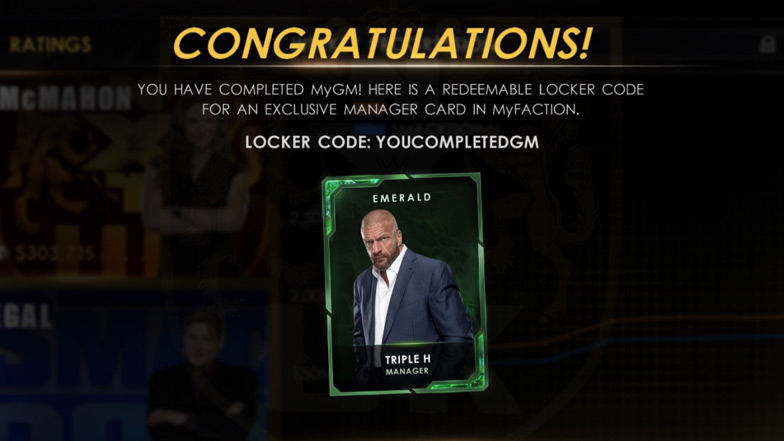
Which GM Should You Pick?
There are five GM choices for you to choose between, or you can opt to use a custom superstar – I didn’t explore the latter option in my first MyGM career.

Going into game modes like this, I always prioritize one thing: money.
I checked out each of the GM’s unique power card and Stephanie McMahon’s appealed to me, ‘The McMahon Presence’. This power card can be used once and allows you to generate 2x the money from your arena attendance in a week.
To give you a rough idea of how much this can be worth, I generated $150,000 from my arena attendance during Week 15, Wrestlemania, of my first MyGM career. I had already used the power card by this point, and I was only playing a 15-week season to try to learn as much as I could as quickly as possible, but it shows just how valuable this could be – it would have been worth $150,000 in additional profit. If I’d played a longer season and I’d unlocked even bigger venues, it would have been worth more.

If you compare this to another GM, William Regal, his power card ‘Legend Whisperer’ allows you to sign a Legend for free.
Now, mild spoiler for later in this guide, I signed The Undertaker as my first Legend. His cost, on a 10-week contract, was $208,000.
In hindsight, one thing is clear: I made the wrong choice picking Stephanie McMahon – for a 15-week season, at least. If I’d played a 50-week season and had time to unlock bigger venues, the money that Stephanie’s power card would generate me could’ve potentially bested the money saved on a free legend. Instead, I was down at least $58,000, probably more.
As for the other GMs, their bonuses aren’t as clear to demonstrate the value of.
Adam Pearce’s card ‘Instigator’ allows you to increase all active rivalries by one level. This could be very valuable if you’ve built up storylines at the right time, but does require the delicate balancing act from you as the player to make it pay off. This one isn’t likely to pay off in cold hard cash, but is likely to win you more fans – and ultimately it’s the number of fans you have that decides who wins and loses in GM Mode.
Sonya Deville’s power card ‘A Superstar’s GM’ raises the morale of your roster by 15 points. If you’re a good manager then you shouldn’t have to worry about morale too much either way, so I don’t think Sonya is worth picking.
Shane McMahon’s ‘Coast to Coast’ power card gives you +2 on your show bonus when GM interference is added to the show. This is great, but the downside to GM interference is that you’re going to damage the morale of one of your fighters (the fighter you gang up against). It’s hard to determine exactly how much benefit this gives, but like with Adam Pearce’s card, it is focused on gaining fans rather than revenue.
In my opinion, it’s better to focus on revenue, then use that revenue to drive fans over the long-term. I think William Regal is the best GM to pick, though Adam Pearce is another very strong option that can bail you out of some tricky low rivalry situations.
If you choose to use a created superstar rather than any of the five options we discussed above, your power card is ‘Beginner’s Luck’, which raises the popularity of your least popular wrestler by 20 points.
Honestly, this is a really great power card as it allows you to sign an unpopular free agent for extremely cheap and then immediately make them popular, giving you the chance to begin creating rivalries with them from the get-go.
I’d include your own created superstar in my top 3 picks for the best GM to choose in MyGM in WWE 2K22.
Which Brand to Go For
The next thing you need to do is select which brand you’re going to manage out of SmackDown, Raw, NXT or NXT UK.
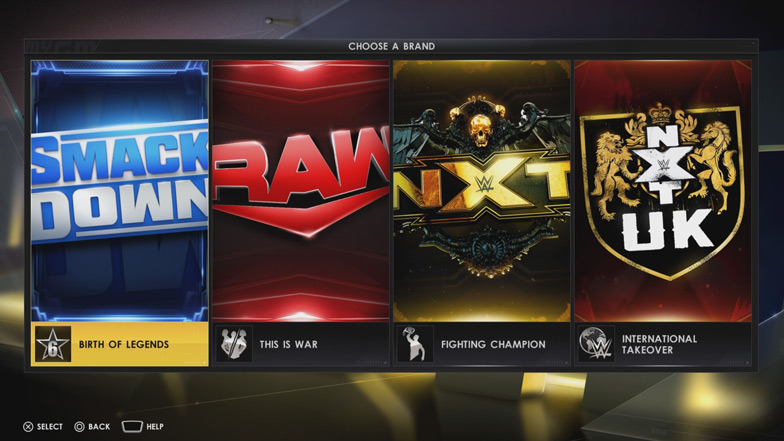
Choosing SmackDown will give you a power card that generates +6 popularity on 6 random superstars on your roster.
Raw will allow you to prevent 3 randomly selected superstars from fighting on your opposing brand in next week’s fights, but can’t be used directly before a PPV.
NXT’s power card gives you a large match rating boost on title matches within the week the card is played.
And with NXT UK, your power card gives you a 2-3x boost on your network deal, depending on whether you lose fans or gain fans in that week.
As we’ve already discussed, I believe it’s best to focus on revenue, and I prefer to choose things where I can see the direct benefit rather than needing to work out a whole load of factors.
Therefore, I chose NXT UK, and its ‘International Takeover’ power card ended up being worth $36,000 to me (the network deal was worth $18,000 and I gained fans in that week, which meant my revenue from this was trebled).
Was this $36,000 worth it? I’m not sure.
If I could turn back the clocks, and if I was playing against a human opponent rather than AI, I would probably choose Raw – that card looks extremely annoying to come up against and could lead to fatigue and injuries, as well as ratings drops and more (for your opponent).
I wouldn’t really have any issues picking NXT UK again – if the network deal increases in value in longer seasons, it would become more valuable and I’d definitely snap up this brand.
Draft Tips
After picking your GM and brand, the next thing to do is draft your roster of wrestlers.
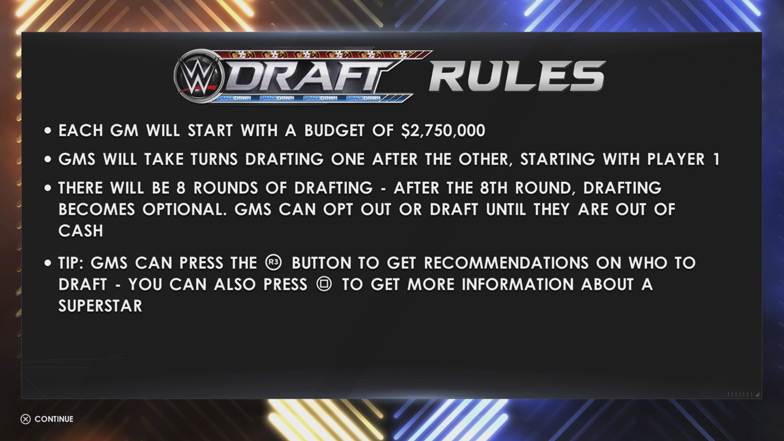
You will start with a budget of $2.75m and will need to draft at least 8 wrestlers, though you can optionally draft more.
The fighters you can choose between does vary from save to save. I fired up two different game files to see if the draft differs and it clearly does.
My first options included Drew McIntyre and Edge (amongst many others), whereas my second draft – the save I stuck with for this guide – included Brock Lesnar and Roman Reigns. Both drafts included John Cena and Becky Lynch, so some overlap can and will happen.
I chose to draft 10 wrestlers. My AI opponent drafted 14, and I quickly saw why they went for quite a few more than I did – I needed more numbers and fast.
From the initial draft, I think 12 might be the sweet spot. You need to factor in a variety of things, though; your budget, roles, classes, matchups and more.
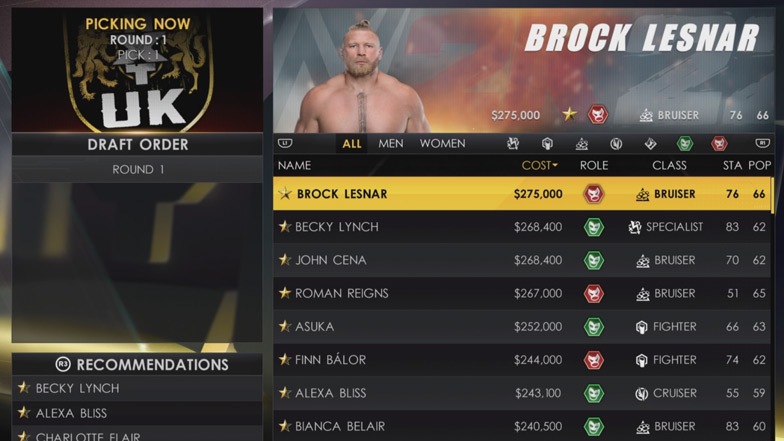
I think if you draft 12 and then go on to pick up a Legend and a Free Agent afterwards to finish with 14 fighters, you should be in good shape.
I recommend drafting 12 fighters and ensuring that you finish the draft with at least $400,000 in your budget.
This $400,000 will then be used to sign a Legend, a Free Agent, and some will be saved to put towards future unlocks (such as bigger venues or better pyrotechnics) and shows.
It’s very important to get variety in the fighters you choose to draft. Pay special attention to their star rating (to the left of their name), their role and their class – but you also need to look at their cost, stamina and popularity too.
The goal is to get a roster of fighters that are all as popular as possible, so do prioritize popularity, but you will need to sacrifice popularity sometimes to get the balance your brand will need.
Stamina is an important figure to look at too – if you’re playing a 15-week season, you don’t want to commit $250,000 to a wrestler that can barely fight for the first few weeks.
Draft Team Breakdown
Paying special attention to popularity and stamina, here’s the team breakdown I recommend trying to get:
- 2 x male Fighters
- 2 x male Brawlers
- 1 x male Giant
- 1 x male Cruiser
- 2 x female Fighters
- 2 x female Brawlers
Update: I’ve now done a second full MyGM career and drafted 6 females and 4 males – the same breakdown applies. I didn’t draft any Specialists second time round and saw more success.
With your fighters, you either want both Fighters to be ‘Fan Favorites’ or both to be ‘Rule Breakers’. Fan Favorites have the green icon on their role, Rule Breakers have a red icon.
The same as the above goes for your Brawlers – aim for 2 within each role.
This is so you can pit 2 x Fighters against 2 x Brawlers in tag team matches, or you can have a tag team that includes one of each on each team, and you also have a variety of options for 1v1 matches.
You may notice that the breakdown above only includes 10 wrestlers and I recommended going for 12. This is because you need to have some flexibility on who you’re drafting – it’s unlikely that you’ll manage to get the exact breakdown as above due to the options within your draft.
For example, if you have the choice to get the final Brawler you need, but it’s a 2-star 40 Popularity wrestler with 45 Stamina, and you have an alternative option of a 3-star, 60 Popularity, 80 Stamina Specialist, you may be better off going with the latter.
Depending on how favorable your draft is, you’ll hopefully be able to work towards getting the 10 classes listed above.
Then, draft another two fighters, and look at your budget to determine if you’re going to splash out on superstars or if you just need rotational cover to allow your previously-drafted superstars some rest during busy weeks of the season.
Signing Legends
There are a large number of Legends you can sign on short-term contracts to your brand. If things go well, you can extend their contracts.
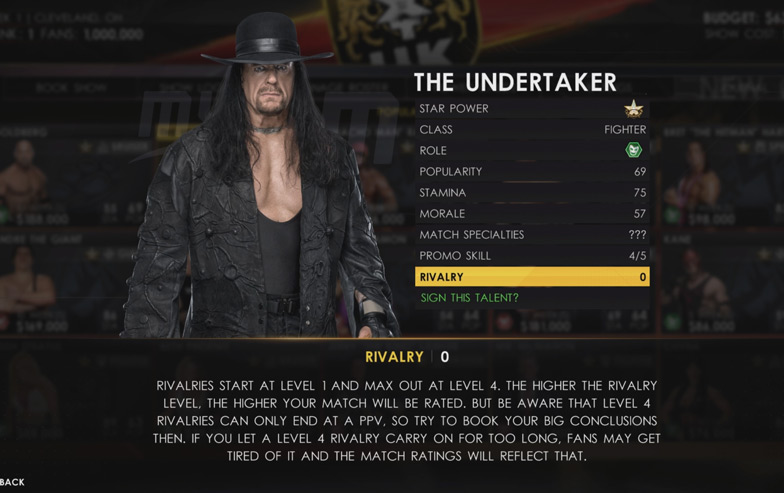
In my draft, I signed The Undertaker, even though he was one of the most expensive options.
The reason for this was simple – I had already drafted Brock Lesnar, a 4-star, 66 Popularity Bruiser in the Rule Breaker class. The Undertaker was the perfect rival for him; a 5-star, 69 Popularity Fighter in the Fan Favorite class.
Not only were these the perfect match to pit against one another, they also both had stamina – allowing me to begin forging their rivalry in a Week One title fight.
When looking to sign a Legend of your own, be sure to analyze your existing roster and look to see if a Legend can actually make much of a difference to it at this moment in time. Do you have a fighter that’s primed and ready for a legendary match-up?
You’ll definitely want to get a Legend in your roster, but the match-up is the most important part. This is how you’ll put your money to best use.
Free Agents
Free Agents in the game have a couple of uses.
The wrestlers that went undrafted in the starting draft will appear here, so there are some options that provide a bit of quality if you’re in need of depth to your roster – perhaps your fighters are tired or injured, for example – but there are also some extremely low rated, unpopular wrestlers here too.
Why would you draft a low-rated, unpopular free agent, you may ask? Because they’re so cheap.
If you can gradually build up the popularity of an unknown free agent, you’ll have a bargain on your hands.
These lesser-known wrestlers are useful for putting in the middle of your show cards during quieter weeks, giving important resting time to those that have real rivalries brewing.
No, they’re not going to generate incredible spectacles, but over the long-term they can be valuable pickups.
Organizing Shows & Big Events
When booking your shows, remember one thing: you always want your show to start and finish strongly. This means you want your first fight to be great, and you want the last fight – the main event – to be an absolute banger.
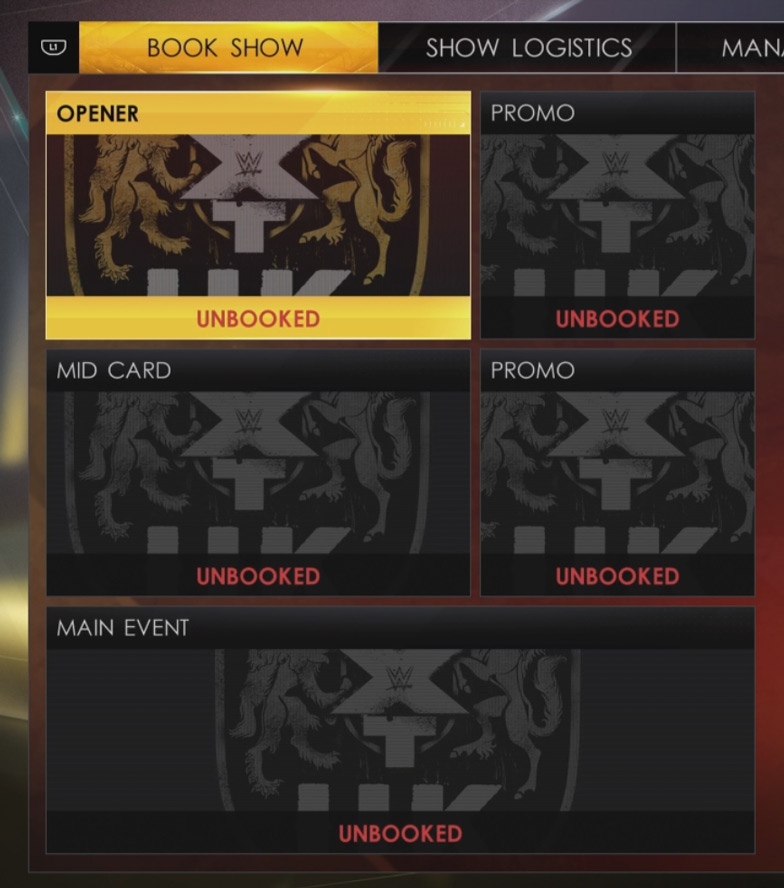
The mid card should be used for the least entertaining fight of the night, but can still be a useful slot for developing or fuelling rivalries.
Before you start to book fights for an event, check your Commissioner Goal under ‘Journal’. You should always try to complete this because you’ll be awarded bonuses for doing so, so prioritize it.
You’ll want your show card to have at least one tag team match and fights from different genders happening too, as well as a variety of match types.
The other thing you need to do is be aware of when your big events are happening and where rivalries are at – you want your wrestlers to be slowly developing specific enemies, and you want any rivalry to culminate at a big PPV event, which happens every few weeks and you’ll be given a continual countdown to remind you of when the next one is.
If you’re not great at keeping track of everything, I recommend pen and paper for this, or a spreadsheet. Make a note of which fighters fought and when, so you can ensure they’re rested and that, more importantly, you don’t overuse the same fight pairings.
You ideally want a Level 4 rivalry to be the main event of big PPV shows. It’s even better if they’re title fights.
To get Level 4 rivalries, have your wrestlers fight and then use a ‘call out’ Promo within a card to rest one of the fighters, but also to stoke the rivalry further. Don’t have either of the fighters fighting other people unless it’s a tag team match. You should have them fight 3-4 times in total, along with using call outs, to build the rivalry to Level 4. You’ll want this to happen around 2 weeks out from a PPV event, so you can have them fight on a stacked card and then their rivalry will end.
Not only will you want to be building active rivalries, but if you’re playing a long season (i.e. longer than 15 weeks) then you’ll need to be thinking about future rivalries too.
If a level 4 rivalry fight is taking place, you could have a different fighter call out one of the other fighters from the main event during the same show, hoping to spark a Level 1 rivalry going into the next set of events after the PPV is complete.
Maximizing Revenue & Profit
If you’ve read through this whole WWE 2K22 MyGM guide so far, you’ll know that I believe in one thing: money. Money is what allows you to put on bigger and better shows.
If you can handle the ins-and-outs of developing rivalries and putting on diverse and entertaining fight cards, your only other focus should be on ensuring your shows can bring more money and more fans in.
The old saying is true, you need to spend money to make money. This means you absolutely can’t go into a show without any money in the bank – you’ll want $100,000 at least to put on your shows (this may be tougher in the first couple of weeks).

You should focus your spending on putting on a great show; bigger arenas is where you’ll want to be heading to get the maximum out of the most lucrative form of income – ticket sales.
Your venue should always be the priority, but you’ll want to keep the fans happy too by investing in crew, pyrotechnics and more. But you’ll never want to splash out on an incredible show in a small venue – you simply won’t make the money back.
In bigger venues, if you’ve had successful cards previously, you’re almost guaranteed to make a profit. In fact, I didn’t have a single show where I didn’t make more money than I spent. And I spent as big as possible almost every time.
My top tip is to keep your roster as small as it can be. Yes, it might need to grow a little to accommodate certain things, or there might be a Legend that could transform the future of your brand, but you want to run a tight ship. The less you’re spenders on your roster, the more you can spend on putting on an amazing show.
An amazing show will bring in more money and more fans.
Promos
If you put a wrestler into a promo, they won’t be fighting in that week’s show. This is a good way to give a bit of rest (though not as much rest as if you give them the week off entirely) whilst trying to build their popularity or develop rivalries.
It can also be used to make a bit of cash – it costs $0 to get them to ‘advertise’ and it will make you some cash, but the chosen wrestler’s popularity will go down a little bit as a result. Use the advertise option sparingly.
You don’t have to run promos all the time, meaning you can keep the odd slot free if you’d prefer to prioritize rest and stamina recovery. However, you should use the ‘call out’ promo to be continuing to develop rivalries, and you can use the other options too to make cash or bring in fans.
I recommend you run as many promos as you can, only choosing to not run one if the choice is to stick a 40-something stamina (or lower) wrestler in. It would be better to give them the week off.
There is a statistic you can look at to see how likely a promo is to be successful – when selecting your participant, look at their ‘Promo Skill’ score on the left-hand side of the screen.
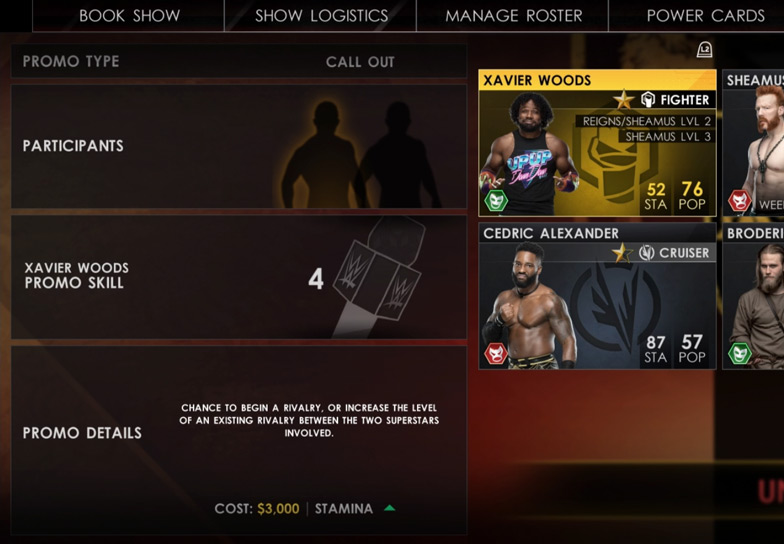
This skill is on a scale of 1-5, with 5 being the best.
You can still throw participants in if their score is 1 or 2, but it might be better to get them to focus on call outs, rather than asking them to advertise or do charity work.
Keeping Fighters Happy
One important thing to consider is how you’re going to keep your fighters happy. If they’re unhappy, they might walk away and leave for your rival’s brand instead.
Some things that I discovered that will almost definitely make your fighters angry or lose morale is GM interference (when it’s not in their favor, at least), not fighting them often enough, refusing to give them bonuses or trying to negotiate their renewals down.
Sometimes you can’t avoid making a fighter unhappy – sometimes it is genuinely unavoidable, sometimes there is a bigger pay-off by making them upset.
For example, a GM interference might be an objective that gets you big rewards and makes the one fighter happier than they were previously…but you might have a tough task to convince the upset party to stay and fight for their future.
Summary
In summary, my top tips for MyGM in WWE 2K22 are pretty simple:
- Run a tight ship – don’t have too many wrestlers on your roster
- Ensure shows start well and end with a bang – the middle should be your worst fight, the last should be the best
- Always try to match wrestlers up against their opposites – brawlers should fight fighters, giants should fight cruisers. Specialists are OK, but they’re tough to maximize rivalries with because their fights aren’t entertaining enough.
- Ensure level 4 rivals only fight at PPV – don’t allow fans to become bored of the rivalry before it gets the chance to reach its best possible conclusion.
- Spend money on your shows, especially on the venue – spending money makes you money, when it comes to this area. Signing fighters doesn’t have such a clear and obvious ROI compared to this.
This guide has been written during the game’s pre-release. I will update any parts, if necessary, after multiple playthroughs – and longer playthroughs. If you have any feedback or suggestions to make this guide even more useful, do leave a comment below!

